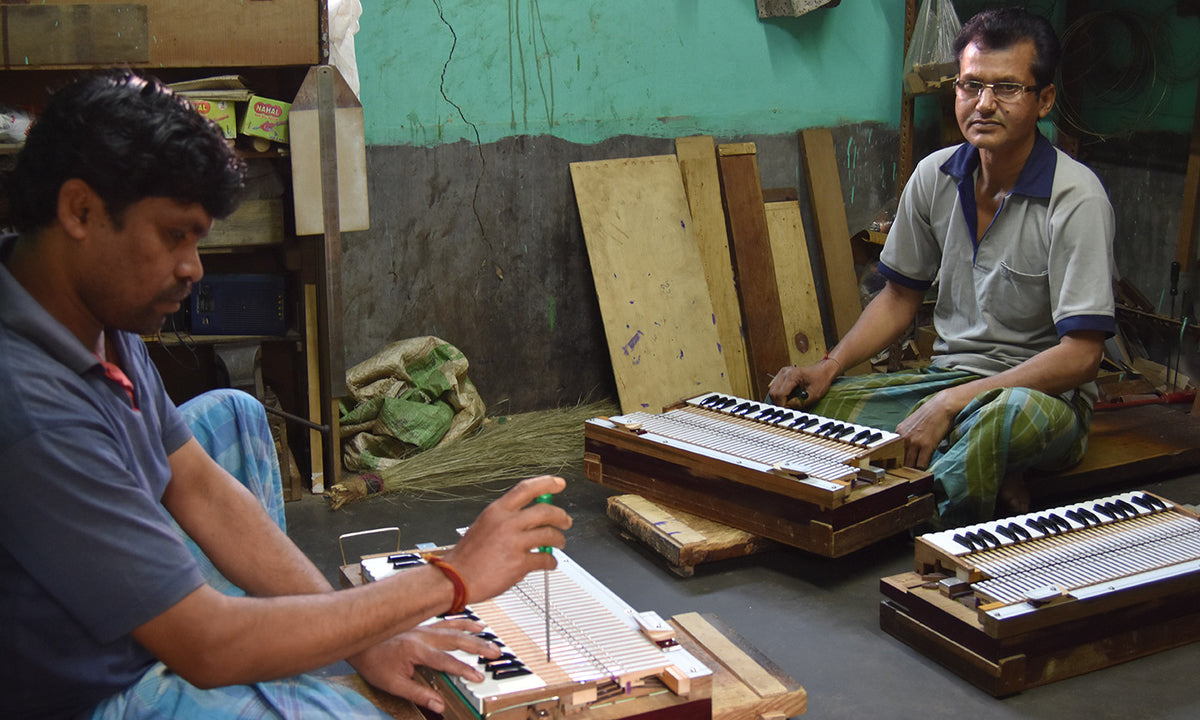Modern Cottage Industry: India's musical instrument "maker" scene

Paul & Co. harmonium production - Howrah, West Bengal. Photo by Nic Dillon
RING, RING.
I get a lot of calls from customers looking for aesthetically "perfect" Indian instruments, and I get that. You're shopping for something new, and you want it to look new. Right?
These conversations usually begin with some explanation of what I've come to recognize as - a disconnect - between what is happening in the workshops of India and what I think most people imagine.
I explain it this way:
While modern India is certainly seeing an evolution in tech and other industries, the production of traditional folk musical instruments (i.e. the stuff we sell at Old Delhi Music) is still a distinctly "Cottage Industry."
THERE ARE NO FACTORIES.
Where you might imagine a production line, you're more likely to find a single workbench or (more often) a craftsman working on a concrete floor.

Sitar production in Kolkata. Photo by Nic Dillon
THERE ARE NO MACHINES.
In place of a computer sequenced router cutting perfectly matched pieces from plywood panels, you find only hand tools wielded with incredible human precision and efficiency.

Mukta Das refining a tabla in Kolkata. Photo by Nic Dillon
THERE ARE NO SPRAY BOOTHS.
They don't even have modern poly-finishes available. Instead, it's just Shellac and Lacquer applied carefully by hand in an open air finishing environment.

Harmonium finishing in Ghaziabad, Uttar Pradesh. Photo by Nic Dillon
THE RESULT.
The well preserved tradition of making instruments in India represents a pace of life and dedication to a craft that is increasingly rare, and I am thankful to get to work in cooperation with these makers.
While they may not come out of a "perfect" environment, I see an undeniable beauty in these unique, handmade treasures.
OUR ROLE.
Life would be easier if the things we import were perfectly consistent, but I don't desire to see the tradition of Indian instrument production mechanized any time soon.
The consistency and performance my customers want and we desire to achieve comes from the processes we employ in our little workshop here in the U.S.
Our role is to tweak and refine these inherently unique instruments until they meet our own standards for quality and outperform anything you might find in India or elsewhere.
Only when we are satisfied, do we pass these instruments along to our customers.

That's me tweaking harmoniums alongside some builders in India. Photo by Jeff Dillon
OUR OBJECTIVE.
I'm no longer trying to obtain perfect Indian instruments, but rather, the very best of what is being produced - little imperfections and all.
It's taken years for me to develop this appreciation and perspective, and if you spoke to the builders I am closest too, they'd probably still describe me as "quite picky."
Either way, as I've traveled and spent time with them, my love for these craftsmen, their lifestyle, and the traditions I'm enabling them to continue has developed along my own patience and grace for the imperfection of it all.


I would like to have a tape or tutorial so that when I tune the tamboura,I know what it is suppose to sound like. Is this possible for female tamboura. Also aren’t there smaller tamboura than 52 inch neck. I owned a smaller one from Rikki Ram many years ago. Thank you, Vicki Riska
Hear, hear! I personally told myself that I wanted to purchase my next harmonium from you because if this attitude. I own a Bina standard dulcetina; it’s one of my favorite instruments to play and only recently I noticed a piece of the teak had obviously been broken and glued back together before the shellac was applied . I love that. Sure, it might be considered an imperfection, but it has no effect on playability and shows an economy with materials that I appreciate.
That said, I do appreciate that you check the instruments against a high standard and will tune to A440 (which is why I ordered a harmonium from you recently). Keep up the good work!
Dave